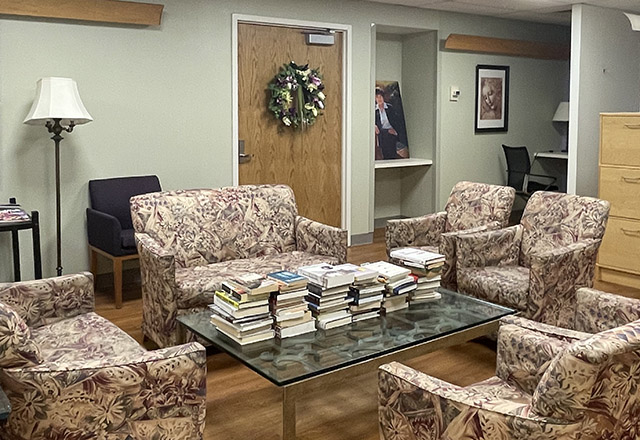Tucked away on the first floor of The Johns Hopkins Hospital is a room that looks closer to a 19th-century parlor than anything having to do with clinical care. The room is covered with patterned sofas, lamps and reading nooks. Littered around are books covering everything from women’s history and leadership to guides on physical examination.
This is the Mary Elizabeth Garrett Room, which has existed since 1916 as a space for women graduate students and physicians at Johns Hopkins. It was originally located in the Billings Administration Building, before being moved to the Harvey/Nelson Tower in 1960. The room also houses portraits of inductees of the Johns Hopkins Women’s Medical Alumnae Association Hall of Fame.
Mary Elizabeth Garrett (1854–1915) was a suffragist and social reformer who deeply loved learning. She grew up in Mount Vernon Place in Baltimore to a father who was president of a railroad company. When she was in school, girls were barred from studying science. Naturally, she formed a study group with her friends Julia Rogers and Elizabeth King, and they dissected a rat together to learn biology. She taught herself to be fluent in Italian and French, and picked up some German and Greek along the way.
The Johns Hopkins University School of Medicine might not have existed without Garrett. The school board had already used up all of its original endowment and had insufficient funds to complete construction. Garrett seized the opportunity, creating the Women’s Medical School Fund committee with her friends. She provided the rest of the funds to Johns Hopkins to open the school of medicine on the condition that women medical students would be granted entry and would receive the same opportunities as men. She also required that the university set stringent academic standards for admission and for granting medical degrees, which was not the norm for American medical education compared to standards in Europe.
Garrett’s gift to the university and her skilled negotiation have shaped modern medical education in this country. She set standards for excellence and accountability that physicians would have mastery over a defined body of knowledge. She defined the Doctor of Medicine degree as one that was open to women, with three women being part of the school of medicine’s inaugural 1893 class.
While we often credit The Johns Hopkins University as a model for the development of American medical education, much of this would not have happened without the direct influence of Mary Elizabeth Garrett. Although she was denied entrance to the university herself at the age of 22, she institutionalized opportunities for women, who have contributed to the innovation that Hopkins is known for today. The Mary Elizabeth Garrett Room is a reminder of how hard women have worked to have a place in medicine, and how much we are able to accomplish when we come together and demand more.
Related Content
Want to read more from the Johns Hopkins School of Medicine? Subscribe to the Biomedical Odyssey blog and receive new posts directly in your inbox.
